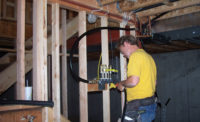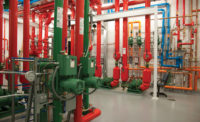Electric radiant. It can be the right technology for some interesting spaces.
“As floor heating grows more affordable than ever, and electric radiant offers an efficient eco-friendly solution, homes and businesses are adding these systems,” says Kyle Stubbs, communications specialist for Heatizon Systems. “Snow melting and roof de-icing are also gaining popularity for homes and businesses seeking to improve safety and convenience.”
Out-of-the-ordinary electric radiant projects include heating reptile rocks at the zoo and warming alligator breeding ponds, as well as dog runs, motor homes, concrete benches and greenhouse planter boxes.
“Electric cable system installations are more common in residential applications for floor warming; however we have seen the use of electric cable for snow-melt applications in commercial projects, as well,” says Michael E. Willburn, president of Infloor Heating Systems. “We have seen electric cable used to heat the shower floor as well as the seating benches in the shower. We have even seen our cable system used in outdoor patios for space conditioning or patio warming in some of the southern climates, mainly just to take the chill off of the stone surfaces.”
Electric radiant is gradually becoming more accepted, so there’s some growth, adds Rich McNally, Eastern region sales manager for Watts Water Technologies. Managers of higher-end hotels are now specifying it for bathrooms and showers. Corporate centers are catching on.
“And, for homes – sure, it’s happening, but not yet at the levels we were seeing seven or eight years ago,” McNally says. “I was especially interested in seeing my first kitchen countertop warming application, and shower heating, too. Another interesting use of electric radiant is in the joist bays from below a subfloor – very similar to the application of heat by the use of tubing to convey heat for a hydronic radiant install.”
pme: Is electric radiant still considered a solution for small spaces such as bathrooms?
MW: Electric cable is still a great product for small spaces like bathrooms, kitchens and entryways. It is also a great choice for anywhere tile, marble and stone surfaces are used.
RM: Yes, it’s well suited for that, especially for homes and businesses that may not already have hydronic systems in place to provide the warmth. The systems are easy to install and are often used for floor warming to take the chill out of an otherwise luxurious tile or stone floor. The systems also can be used for supplemental heat, or even as the primary source of heat.
pme: Where does electric radiant work as well or better than hydronic radiant?
MW: Electric cable systems work as well or better than a hydronic system when remodeling projects come into play, such as when you are replacing the tile in an existing bathroom on a concrete slab where there is no room for the mechanical system required for a hydronic system or the floor height to install a typical hydronic radiant floor system. Other examples might be where the project requires more of a cooling load than heating and the customer only wants warm floors in specific areas of their house.
KS: Heatizon believes electric radiant to be superior to hydronic in every application. Electric radiant works far better for roof de-icing as it is easier to install and maintain, and requires less accommodations when roofing. Electric radiant has made great gains in floor- and space-heating use.
As altitude impacts boiler efficiency, electric systems run at 100% efficiency. Electric radiant also provides an even heat, where hydronics fluid cools as it circulates away from the boiler. Another factor is the controls involved. Electric systems require small control units that can easily be installed in crawl spaces, attics, garages and other locations.
RM: Electric radiant is ideally suited for spot warming, and especially where there currently is no source for hydronic heat; yet, some home and building owners prefer the simplicity of electric radiant – no circulation of fluids or equipment to maintain. It works just as well and is as comfortable as hydronic radiant, yet when the cost of operating a large system is compared – looking at electric or hydronic – hydronics typically wins for energy efficiency. Come to think of it, electric radiant heat makes sense in every home in America.
pme: What’s the protocol for sizing electric radiant to a space?
RM: Mostly, mats are preconfigured – and that’s to the advantage of installers, for sure. A lot of work goes in to a system design, for instance to determine a layout for electric radiant mats using a home, or room’s, exact dimensions. These layouts consider point-of-entry for the electricity (where the thermostat), location of the thermostatic sensor, room layout to include for instance placement of a kitchen island, and finally the point of a mat’s termination.
MW: Normally when sizing electric cable systems we need to get some information from the customer. Is the application 120V or 240V? Is the application on top of a concrete slab or a wood subfloor with insulation under the subfloor? How many square feet is the application? What type of floor covering will be used with this system?
Once we have all the information, the system is quite easy to size based on cable spacing and watts per square foot. We use a cable product that is not attached to a mat. This makes our system quite easy to install in all types of room configurations without having to order a particular sized mat.
KS: This depends on the product being used. However, it is still important to plan ahead to ensure appropriate controls and properly sized transformers are provided for the space being heated.
This article was originally titled “Plug it in” in the March 2016 print edition of PM Engineer (pme).




